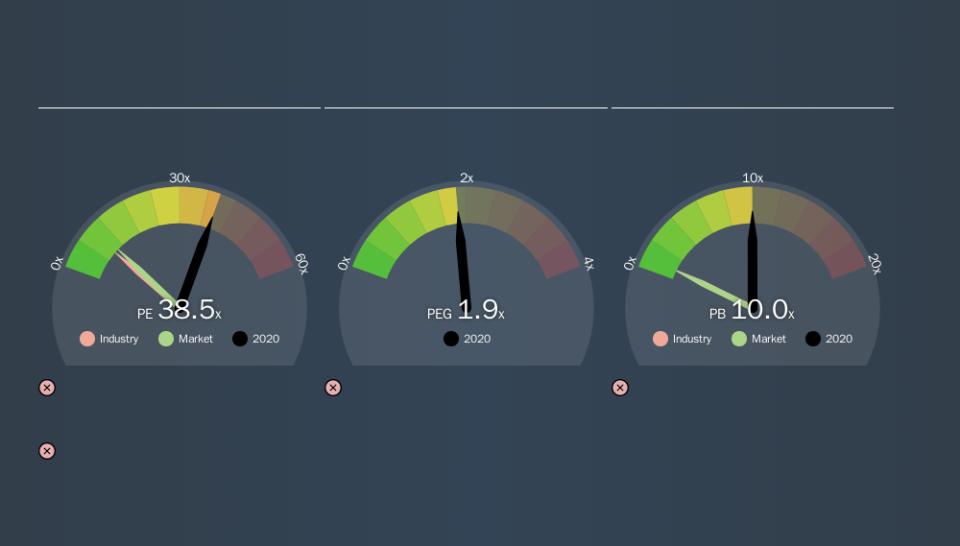Is ANTA Sports Products Limited's (HKG:2020) High P/E Ratio A Problem For Investors?

This article is written for those who want to get better at using price to earnings ratios (P/E ratios). To keep it practical, we'll show how ANTA Sports Products Limited's (HKG:2020) P/E ratio could help you assess the value on offer. What is ANTA Sports Products's P/E ratio? Well, based on the last twelve months it is 38.54. That means that at current prices, buyers pay HK$38.54 for every HK$1 in trailing yearly profits.
See our latest analysis for ANTA Sports Products
How Do I Calculate ANTA Sports Products's Price To Earnings Ratio?
The formula for P/E is:
Price to Earnings Ratio = Price per Share (in the reporting currency) ÷ Earnings per Share (EPS)
Or for ANTA Sports Products:
P/E of 38.54 = HK$66.62 (Note: this is the share price in the reporting currency, namely, CNY ) ÷ HK$1.73 (Based on the trailing twelve months to June 2019.)
Is A High P/E Ratio Good?
The higher the P/E ratio, the higher the price tag of a business, relative to its trailing earnings. That is not a good or a bad thing per se, but a high P/E does imply buyers are optimistic about the future.
How Does ANTA Sports Products's P/E Ratio Compare To Its Peers?
The P/E ratio indicates whether the market has higher or lower expectations of a company. As you can see below, ANTA Sports Products has a much higher P/E than the average company (8.9) in the luxury industry.
That means that the market expects ANTA Sports Products will outperform other companies in its industry. Shareholders are clearly optimistic, but the future is always uncertain. So further research is always essential. I often monitor director buying and selling.
How Growth Rates Impact P/E Ratios
Earnings growth rates have a big influence on P/E ratios. That's because companies that grow earnings per share quickly will rapidly increase the 'E' in the equation. That means unless the share price increases, the P/E will reduce in a few years. So while a stock may look expensive based on past earnings, it could be cheap based on future earnings.
ANTA Sports Products increased earnings per share by a whopping 30% last year. And its annual EPS growth rate over 5 years is 24%. With that performance, I would expect it to have an above average P/E ratio.
A Limitation: P/E Ratios Ignore Debt and Cash In The Bank
Don't forget that the P/E ratio considers market capitalization. So it won't reflect the advantage of cash, or disadvantage of debt. In theory, a company can lower its future P/E ratio by using cash or debt to invest in growth.
Such expenditure might be good or bad, in the long term, but the point here is that the balance sheet is not reflected by this ratio.
So What Does ANTA Sports Products's Balance Sheet Tell Us?
Since ANTA Sports Products holds net cash of CN¥1.1b, it can spend on growth, justifying a higher P/E ratio than otherwise.
The Bottom Line On ANTA Sports Products's P/E Ratio
ANTA Sports Products has a P/E of 38.5. That's significantly higher than the average in its market, which is 10.2. Its net cash position supports a higher P/E ratio, as does its solid recent earnings growth. So it does not seem strange that the P/E is above average.
When the market is wrong about a stock, it gives savvy investors an opportunity. People often underestimate remarkable growth -- so investors can make money when fast growth is not fully appreciated. So this free report on the analyst consensus forecasts could help you make a master move on this stock.
You might be able to find a better buy than ANTA Sports Products. If you want a selection of possible winners, check out this free list of interesting companies that trade on a P/E below 20 (but have proven they can grow earnings).
We aim to bring you long-term focused research analysis driven by fundamental data. Note that our analysis may not factor in the latest price-sensitive company announcements or qualitative material.
If you spot an error that warrants correction, please contact the editor at editorial-team@simplywallst.com. This article by Simply Wall St is general in nature. It does not constitute a recommendation to buy or sell any stock, and does not take account of your objectives, or your financial situation. Simply Wall St has no position in the stocks mentioned. Thank you for reading.


